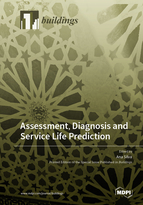Assessment, Diagnosis and Service Life Prediction
A special issue of Buildings (ISSN 2075-5309). This special issue belongs to the section "Construction Management, and Computers & Digitization".
Deadline for manuscript submissions: closed (31 March 2022) | Viewed by 28247
Special Issue Editor
Interests: pathology and rehabilitation of buildings; service life prediction, durability and life cycle of buildings and their components.
Special Issues, Collections and Topics in MDPI journals
Special Issue Information
Dear Colleagues,
Service life prediction is crucial for the adoption of more sustainable solutions, allowing optimizing the costs and environmental impact of buildings during their life cycle. Accurate assessment of the service life of buildings requires a thorough understanding of degradation mechanisms and material’s behavior. Building pathology assessment methods allow characterizing the deterioration state of the buildings and their components, using as indicators specific measurable properties. Based on this information, different service life prediction methodologies can be defined, in order to provide reliable data concerning the most probable failure time of buildings and components according to their characteristics and their age.
This special issue intends to provide an overview of the existing knowledge related with various aspects of Assessment, Diagnosis and Service Life Prediction of buildings and components.
Original research, theoretical and experimental, case studies, and comprehensive review papers are invited for possible publication in this special issue. Relevant topics to this special issue include, but not limited to the following subjects:
- Building pathology assessment methods;
- Identification and classification of defects in buildings and components;
- Probable causes of defects;
- Diagnosis techniques;
- Appropriate intervention and repair techniques;
- Deterministic service life prediction models;
- Stochastic service life prediction models.
Dr. Ana Silva
Guest Editor
Manuscript Submission Information
Manuscripts should be submitted online at www.mdpi.com by registering and logging in to this website. Once you are registered, click here to go to the submission form. Manuscripts can be submitted until the deadline. All submissions that pass pre-check are peer-reviewed. Accepted papers will be published continuously in the journal (as soon as accepted) and will be listed together on the special issue website. Research articles, review articles as well as short communications are invited. For planned papers, a title and short abstract (about 100 words) can be sent to the Editorial Office for announcement on this website.
Submitted manuscripts should not have been published previously, nor be under consideration for publication elsewhere (except conference proceedings papers). All manuscripts are thoroughly refereed through a single-blind peer-review process. A guide for authors and other relevant information for submission of manuscripts is available on the Instructions for Authors page. Buildings is an international peer-reviewed open access monthly journal published by MDPI.
Please visit the Instructions for Authors page before submitting a manuscript. The Article Processing Charge (APC) for publication in this open access journal is 2600 CHF (Swiss Francs). Submitted papers should be well formatted and use good English. Authors may use MDPI's English editing service prior to publication or during author revisions.
Keywords
- Building pathology assessment methods
- Inspection and diagnosis
- Classification of defects
- Diagnosis techniques
- Service life prediction
- Deterministic models
- Stochastic models






